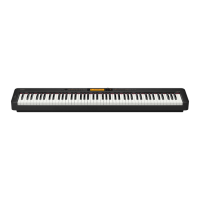About the Timbre Type Tones that are selected by each Instrument part have an attribute that
depends on the sound source operation type. This attribute is called the “timbre type,” which is one of
the types described below.
• Melody
This timbre type optimizes for normal melody tones. The damper pedal performs on/off operations.
• Piano
This Timbre Type is for piano tones. The decay rate of the voice being sounded is seamlessly
altered in accordance with the depressed amount of damper pedal. The method for producing
sound in response to the note messages also is different from that of the melody Timbre Type, and
operation is optimized for piano.
• LMPiano
This Timbre Type is for Linear Morphing piano tones. The decay rate of the voice being sounded
and Damper Resonance effect characteristics are seamlessly altered in accordance with the de-
pressed amount of damper pedal. The method for producing sound in response to the note messages
also is different from that of the melody Timbre Type, and operation is optimized for piano.
• Drum
This setting optimizes for drum sounds. The damper pedal does not function. The Damper Pedal
(Sustain), Channel Coarse Tune, and Master Coarse Tune messages are ignored if they are received.
9 Channel Pressure (Aftertouch)
Message Format: DnH vvH
n: MIDI Channel Number
vv: Value
Receive Receipt adds, to the tone being sounded, modulation of a depth specified by the value. In
the case of a tone that already has modulation applied, receipt of this message increases the modulation
depth. The modulation effect differs according to the tone being used.
10 Pitch Bend Change
Message Format: EnH llH mmH
n: MIDI Channel Number
ll: Value LSB
mm: Value MSB
Transmit Sent when the pitch bend wheel is operated.
Sent when MIDI setting of Accomp MIDI Out set to ON and when automatic accompaniment is
used.
Receive Receipt changes the pitch of the currently sounding note. The range of the pitch change
depends on the Pitch Bend Range value setting.
16

